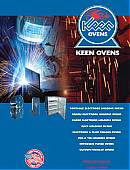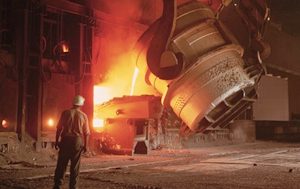Industrial Ovens
Front-Loading
![]() Under 10 cubic feet
Under 10 cubic feet
![]() 10-20 cubic feet
10-20 cubic feet
![]() Over 20 cubic feet
Over 20 cubic feet
![]() See All
See All
Top-Loading
![]() Under 10 cubic feet
Under 10 cubic feet
![]() 10-20 cubic feet
10-20 cubic feet
![]() Over 20 cubic feet
Over 20 cubic feet
![]() See All
See All
Learn About Our Industrial Ovens
Welding Ovens
![]() CONEX Storage
CONEX Storage
![]() Stick Electrodes
Stick Electrodes
![]() Sub-Arc Flux
Sub-Arc Flux
![]() Wire Spools
Wire Spools
![]() Tig Filler Wire
Tig Filler Wire
![]() Multi-Purpose
Multi-Purpose
![]() Nitrogen Purge
Nitrogen Purge
![]() See All
See All
 Order Our Free Catalog Today Click Here |
| Available Inventory |
How Steel is Made: a Brief Summary of a Blast Furnace:
Some examples of ferrous metals would be mild steel, cast iron, high strength steel, and tool steels. Examples of non-ferrous metals would be copper, aluminum, magnesium, titanium, etc. To make steel, iron ore is first mined from the ground. It is then smelted in blast furnaces where the impurities are removed and carbon is added. In fact, a very simple definition of steel is "iron alloyed with carbon, usually less than 1%." The following text is taken from the Structural Manual For Ironworkers
Manual V-Volume I. Iron ore and other iron bearing materials, coke and limestone are charged into the furnace from the top and work their way down, becoming hotter as they sink in the body of the furnace which is called the stack. In the top half of the furnace, gas from burning coke removes a great deal of oxygen from the iron ore. About halfway down, limestone begins to react with impurities in the ore and the coke to form a slag. Ash from the coke is absorbed by the slag. Some silica in the ore is reduced to silicon and dissolves in the iron as does some carbon in the coke. At the bottom of the furnace where temperatures rise well over 3000 Fahrenheit, molten slag floats on a pool of molten iron which is four or five feet deep. Because the slag floats on top of the iron it is possible to drain it off through a slag notch in the furnace. The molten iron is released from the hearth of the furnace through a tap hole. The tapping of iron and slag is the major factor permitting additional materials to be charged at the furnace top. This brief summary of the complex operations of a blast furnace is presented here to provide a point of reference for the actual flow of operations. Very often, several blast furnaces may be arranged in a single plant so that the most efficient possible use can be made of fuels, internal rail facilities, etc.
|
 There are two types
of metals, ferrous & non-ferrous. Ferrous comes from, or contains iron, while
Non-Ferrous does not contain iron.
There are two types
of metals, ferrous & non-ferrous. Ferrous comes from, or contains iron, while
Non-Ferrous does not contain iron.